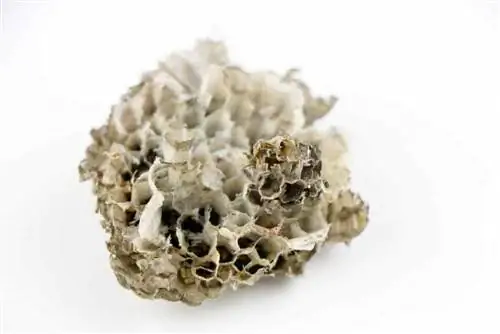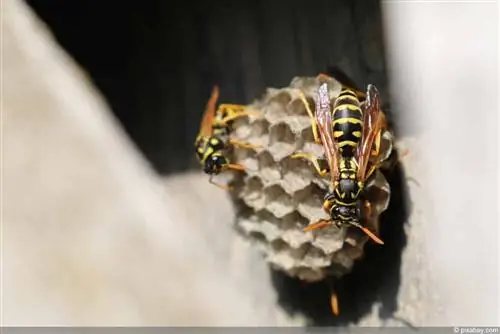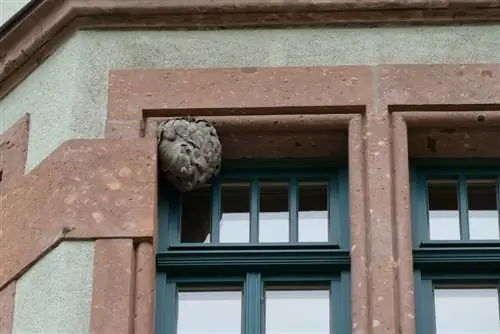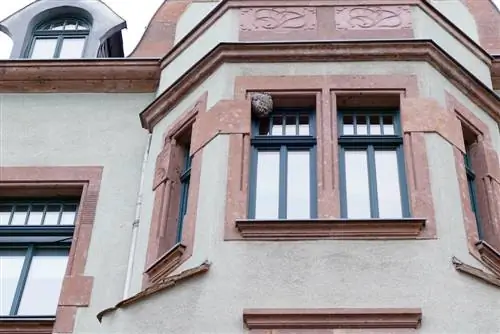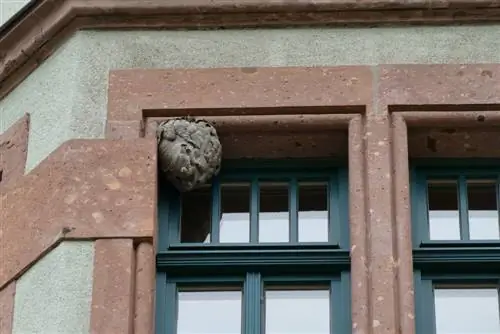- Author admin [email protected].
- Public 2023-12-17 03:39.
- Last modified 2025-01-24 12:45.
For most garden and home owners, wasps are usually uninvited guests that cause nerves and anxiety. These are extremely useful animals that destroy a lot of harmful insects in the garden. They are also skilled builders. Wasp nests are fascinating structures. It's a good idea to deal with them - also to prevent them from being built.
Lifecycle
Anyone who wants or needs to deal with wasp nests is well advised to first take a closer look at the life cycle of a wasp colony. Nest and cycle are interdependent. You have to know that a wasp colony, except for the queen, dies in the winter. In the spring the queen inevitably has to start rebuilding her colony. When exactly it begins depends primarily on the climatic conditions. To do this, she first looks for a protected cavity, such as a roller shutter box or an open eaves, in which she can lay her first eggs. At the same time she starts building the nest. The nest will grow with the colony until the summer and will reach its greatest extent in the months of July and August.
Tip:
If you want to avoid wasp nests in your house, you would do well to close openings in walls, roller shutter boxes, windows or under the roof.
Material
Wasp nests are not built from honey - simply because a wasp, unlike a bee, cannot produce honey. Wasp nests also have a honeycomb-like structure inside, but this has nothing to do with the building material and everything to do with the construction. The building material for wasp nests is exclusively wood. The queen and later the entire colony collect wood fragments that they find in the surrounding area. These fragments are usually peeled by the animals, chewed finely with their mouthparts, salivated and then transported to the nesting site. You can therefore say: Every wasp nest consists of a dried wood pulp that was specially produced by the animals.
Construction
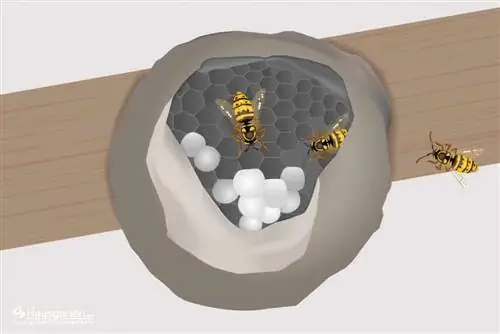
Wasp nests are basically honeycomb-shaped inside. The honeycombs fulfill two functions. On the one hand, they serve as places for laying eggs. On the other hand, they give every nest enormous stability. The queen will begin building ten to 20 honeycombs out of wood pulp in the spring. These first honeycombs are usually well hidden in a cavity and are therefore hardly noticed. Only as the colony grows and the nest expands does it become visible to the outside world. This often creates completely abstract, organic shapes. Only the honeycomb structure on the inside is geometric and surprisingly uniform. The outside, on the other hand, is often reminiscent of a wildly growing ulcer, which is probably one of the reasons why many people are afraid of wasp nests.
Time of origin
As already indicated, the creation of a wasp nest is based on the natural life cycle of a wasp colony. As a general rule, it can be said that it will grow steadily over a period of about six months from spring to mid-summer. The animals only stop expanding further in early autumn. Many nests have already grown considerably. A wasp colony can number 3,000 to 4,000 animals in summer. Since the size depends on the population, the external living conditions play a major role in expansion. Bad weather and a low supply of food usually mean that the colony grows relatively poorly. As a result, it takes up significantly less space, which is of course reflected in the size of the nest.
Dealing
Most of the time, a wasp's nest on the house or somewhere in the garden doesn't cause much joy. Although wasps are very useful animals that every garden owner should be grateful for, many people see red when it comes to wasp nests. However, simply destroying them is not an option. Anyone who hits the nest with a shovel or a large hammer is immediately exposed to an attack from the entire colony - and this attack can not only be very painful, but also dangerous. Something similar can happen if you just want to move the network. Here too, extreme caution is required. Moving should therefore only be carried out by professionals, such as an exterminator or pest controller.

